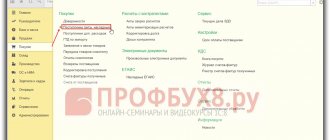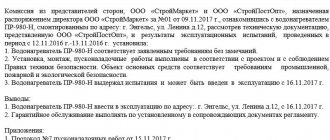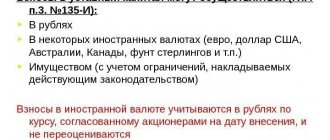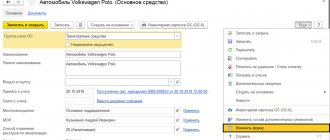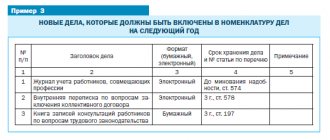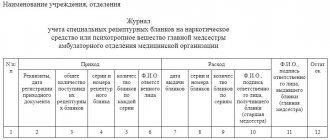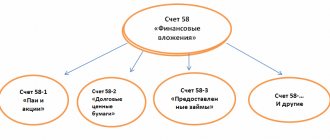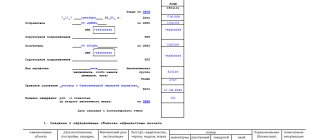Storage agreement
The storage agreement is concluded in writing (subclause 1, clause 1, article 161, clause 1, article 887 of the Civil Code of the Russian Federation). Organizations for which storage is a business activity (commodity warehouses), instead of concluding an agreement, can issue a simple (double) warehouse certificate, which indicates the conditions and storage period of goods and materials (Articles 887, 913, 917 of the Civil Code of the Russian Federation). If, within the period established by the agreement, the depositor does not pick up the goods and materials transferred for storage, the custodian has the right to sell them, having warned their owner about this (clause 2 of Article 899 of the Civil Code of the Russian Federation).
Transfer for safekeeping
When preparing documents in case of transferring goods for safekeeping, you need to pay attention to the following points. Firstly, Resolution of the State Statistics Committee of Russia No. 66 states that when accepting and transferring inventory items for storage to a custodian organization, a corresponding act is drawn up in Form N MX-1.
Moreover, this document is used both for domestic storage and for storage with the participation of professional custodians. It is drawn up by representatives of the parties in accordance with the storage agreement (for a certain period and on demand).
The number of copies of the act and the completeness of the documents drawn up are determined in each specific case.
Secondly, Art. 912 of the Civil Code of the Russian Federation determines that a commodity warehouse issues the following warehouse documents: - double warehouse certificate; - simple warehouse receipt;
- warehouse receipt.
This established list of warehouse documents is exhaustive. At the same time, the requirements for issuing double and simple warehouse receipts are enshrined in the relevant articles of the Civil Code of the Russian Federation.
But the requirements for registering and filling out a warehouse receipt are as follows: - location of the warehouse; — the name of the legal entity from which the goods were received and the location of the goods owner; — name and quantity of goods accepted for storage; - the period for which the goods are accepted for storage; — amount of remuneration for storage (if any);
— date of issue of the warehouse receipt.
However, if you look closely, you can see that Art. 912 refers to § 2 "Storage in a warehouse" Ch. 47 “Storage” of the Civil Code of the Russian Federation, and Art. 887 - to § 1 “General provisions on storage” of the said chapter. In our opinion, the following follows from this.
Acts on acceptance and transfer of goods and services - basic rules for drawing up
By Sergey Mashkov / May 30th, 2021 / Civil law / No Comments
The chart of accounts for accounting the financial and economic activities of organizations, approved by Order of the Ministry of Finance of Russia dated October 31, 2000 N 94n, does not provide for a separate account for reflecting information about materials transferred for storage.
From the Instructions for the Application of the Chart of Accounts for Accounting Financial and Economic Activities of Organizations it follows that information about the storage locations of materials is reflected in analytical accounting under account 10 “Materials”.
In our opinion, in order to reflect transactions involving the transfer of materials for storage to a third party, a separate sub-account can be opened to account 10, for example, “Materials transferred for storage.”
Receipt of inventory items for storage
Documentation of acceptance of inventory items for safekeeping depends on whether they were accepted under a storage agreement or not.
Under a storage agreement, the receipt of goods and materials from organizations and entrepreneurs must be formalized with a transfer and acceptance certificate in form No. MX-1. When returning inventory items to the depositor, a report is drawn up in form No. MX-3. In addition to the list of returned goods and materials, this act indicates the volume and cost of services provided by the custodian. Therefore, there is no need to prepare additional documents on the provision of storage-related services.
After receiving the goods and materials deposited for storage, the depositor must confirm the absence of claims against the custodian organization by signing the journal in Form No. MX-2.
This procedure is established by instructions approved by Resolution of the State Statistics Committee of Russia dated August 9, 1999 No. 66.
There is no unified form of document used to formalize the acceptance of goods and materials for storage from the public. Therefore, when providing storage services to the population, an organization can use standard forms No. MX-1, No. MX-2, No. MX-3 or similar documents developed independently: receipts, receipts, numbered tokens, etc. The issuance of any of these documents will be mean that the storage agreement is concluded in writing (clause 2 of article 887 of the Civil Code of the Russian Federation).
For other agreements (for example, sales and purchases with transfer of ownership after payment), the acceptance of inventory items for safekeeping is documented with invoices (for example, according to forms No. TORG-12, No. 1-T, No. M-15).
Documents upon transfer of fixed assets for safekeeping
They are filled out in accordance with the instructions approved by Resolution of the State Statistics Committee of Russia dated 08/09/1999 No. 66. 2 Each transaction carried out is formalized by a bilateral act of acceptance and transfer, which is signed by the depositor and the custodian (form No. MX-1), as well as acts of return of inventory items (form No. MX-3).
The acceptance and transfer certificate, the number of its copies and the completeness of the package of documents are stipulated in the storage agreement. The return certificate is drawn up in two copies. 3 If it is necessary to use stored equipment for demonstration, as well as to obtain inventory materials from the custodian organization, appoint a responsible person by order of the manager.
This must be a full-time employee of the depositor organization.
Important
In this document you must indicate the following information: - details of the recipient and the deliverer; - date of acceptance and deregistration; - inventory and serial number (according to the card and technical passport); - useful life; - initial and residual value. 3 Draw up the act in duplicate. Sign and affix the organization's seal. Give it to your counterparty for signature. 4 Issue an order to put the equipment into operation. Here you must indicate the original cost of the fixed asset for accounting and tax purposes.
By means of an administrative document, assign an inventory number to the equipment and appoint a person responsible for its storage. 5 Fill out the inventory card, which has a unified form No. OS-6. Here, include all information about the equipment, for example, the date of the last major overhaul, the actual service life.
Responsible storage of property: documentation
MC, their description, quantity and cost, or invoice for the release of materials to the third party according to the unified form No. M-15 (approved by Resolution of the State Statistics Committee of Russia dated October 30, 1997 No. 71a).
According to the Instructions for Budget Accounting (approved by order of the Ministry of Finance of Russia dated February 10, 2006.
No. 25n) the internal movement of fixed assets between financially responsible persons in the institution is reflected in the debit of the corresponding analytical accounts, account 0 101 00 000 “Fixed assets” (0 101 01 310, 0 101 02 310, 0 101 03 310, 0 101 04 310 0 101 05 310, 0 101 063 10, 0 101 07 310, 0 101 08 310, 0 101 09 310) and credit of the corresponding accounts of analytical accounting of the account 0 101 00 000 “Fixed assets” (0 101 01 310, 0 101 02 02 02 02 310, 0 101 03 310, 0 101 04 310, 0 101 05 310, 0 101 06 310, 0 101 07 310, 0 101 08 310, 0 101 09 310).
Transfer of MC for safekeeping
Source: https://lcbg.ru/dokumenty-pri-peredache-na-otvetstvennoe-hranenie-osnovnoe-sredstvo/
Accounting with the custodian
Inventory and materials accepted for storage are not the property of the custodian, therefore they are accounted for separately from his own property in off-balance sheet account 002 “Materials accepted for safekeeping” (clause 10 of the Guidelines approved by Order of the Ministry of Finance of Russia dated December 28, 2001 No. 119n ). Analytical accounting on this account is carried out by owners of inventory items, by grade and storage location (Instructions for the chart of accounts).
Receipt of inventory items for storage, as well as their return to the owner, is reflected with the following entries:
Debit 002
– goods and materials were received for safekeeping;
Credit 002
– goods and materials accepted for storage are returned.
Custodians (commodity warehouses) reflect income and expenses associated with the provision of storage services in accounting as income and expenses for ordinary activities (clause 5 of PBU 10/99, clause 5 of PBU 9/99).
Situation: is it necessary to reflect monthly revenue from the sale of storage services in the accounting of a custodian (warehouse). Is the storage agreement concluded for a period exceeding one month?
Answer: yes, it is necessary.
For custodians (commodity warehouses), revenue from the sale of storage services is income from ordinary activities (clause 5 of PBU 9/99). Revenue is taken into account in an amount equal to the amount of cash receipts and (or) the amount of accounts receivable (clause 6 of PBU 9/99).
Revenue is reflected in accounting if the following conditions are met:
– the organization has the right to receive it;
– the amount of revenue can be determined;
– the service is actually provided to the customer;
– the costs associated with the operation can be determined.
Such rules are established by paragraph 12 of PBU 9/99.
When providing storage services, all of the above conditions can be considered fulfilled on the last day of each month during the contract period. Moreover, the custodian has the right to receive remuneration, even if the storage agreement is terminated early (clause 3 of Article 896 of the Civil Code of the Russian Federation). Remuneration will also be received if the owner refuses the goods and materials transferred for storage. The custodian can sell such property (with notification to the owner) (clause 2 of article 899 of the Civil Code of the Russian Federation). Consequently, the custodian should reflect the revenue from the provision of services under a storage agreement in accounting based on the results of each reporting period, that is, monthly (clause 29 of the Regulations on Accounting and Reporting).
For organizations that have the right to conduct accounting in a simplified form, a special procedure for recording income and expenses is provided (Parts 4, 5, Article 6 of the Law of December 6, 2011 No. 402-FZ).
Transfer of purchased fixed assets for safekeeping
From clause 7.2 of the Concept of Accounting in the Market Economy of Russia (approved by the Methodological Council on Accounting under the Ministry of Finance of Russia, the Presidential Council of the Institute of Professional Accountants on December 29.
1997) it follows that an economic asset, control over which the organization received as a result of the accomplished facts of its economic activities and which should bring it economic benefits in the future, is its asset.
We believe that a necessary condition for exercising control over an asset is that the organization has ownership rights to the corresponding object. Consequently, materials owned by an organization, but transferred for storage, must be taken into account on its balance sheet.
According to clause 7 of the Guidelines for accounting of inventories, approved by Order of the Ministry of Finance of Russia dated December 28, 2001 N 119n (hereinafter referred to as the Guidelines)
Documents upon transfer of fixed assets for safekeeping
Based on paragraph 1 of Art. 887, para. 1 clause 1 art. 161 of the Civil Code of the Russian Federation, a storage agreement between legal entities must be concluded in writing.
The receipt of funds, internal movement, and their release from the warehouse are documented with the following primary documents: - act of acceptance and transfer of basic funds in budgetary institutions f.OS-1 budget.
; — invoice for internal movement of fixed assets f.OS-2; — act of acceptance and delivery of repaired, reconstructed and modernized facilities f.
OS-3; Accounting of fixed assets of an enterprise Depreciation of fixed assets - repayment of the cost of fixed assets.
Accounting for responsible storage of inventory items
The Act records the amount and amount of work performed by the custodian. After the bailor accepts his goods, he must sign in journal No. MX-2 that there is no claim against the bailee.
To provide services for the storage of inventory items to the population, the document can be standard forms No. MX-1, No. MX-2, No. MX-3, and forms developed independently (receipts, checks, tokens).
If a defect is discovered upon acceptance of the goods for safekeeping, then you do not have to issue documents for the defective products.
Simply refuse to accept the goods, documenting your refusal in writing.
Here are the accounting situations for the custody of the custodian and the bailor:
- The custodian organization formalizes the receipt of goods and materials at its own warehouse premises through several operations.
Let's give an example: Products were brought to the company for storage at a cost of 203,000 rubles, the amount of services provided for the safety of products amounted to 18,520 rubles.
Accounting under a property custody agreement
clauses 5, 6, 6.1, 16 of the Accounting Regulations “Expenses of the Organization” PBU 10/99, approved by Order of the Ministry of Finance of Russia dated May 6, 1999 N 33n).
Thus, if this mold is a fixed asset, then the posting will be as follows: D 01 - fixed assets in the organization K 01 - fixed assets in safekeeping.
- (40 kB) (41 kB) (73 kB) (110 kB) (102 kB) (66 kB) (65 kB)
Organization “A” has entered into an agreement for the responsible storage of goods with organization “B”. The goods are stored in the own warehouse of organization “B”.
In turn, organization “A” enters into an agreement with organization “C”.... If an individual entrepreneur will provide services (perform work), is it necessary to draw up an act? Will this work be subject to VAT?
✒ By the certificate of work performed (services rendered), the contractor confirms the fact of execution of the order provided for…. The liquidating company wants to sell us debt claims.
Features of responsible storage of goods
From a legal point of view, it is impossible to conclude a “safe storage” agreement; a document named so will be an ordinary storage agreement within the framework of Art.
47 Civil Code of the Russian Federation. The name accurately reflects the essence of possible and very common circumstances in trade practice, when the supplier has delivered the goods, and the buyer refuses it due to any legislative acts or other legal norms. The buyer intends to return the goods, but until the notified supplier picks it up, it is considered “taken into custody.”
If within a certain period the supplier does not take back his goods or does not dispose of them, the buyer has the right to sell these goods or return them to the supplier himself.
Accounting for the transfer of non-financial assets for safekeeping (Instruction No. 162n)
A storage agreement, which provides for the obligation of the custodian to accept an item for storage, must be concluded in writing, regardless of the composition of the parties to this agreement and the value of the item transferred for storage.
If the storage period is not provided for by the contract and cannot be determined based on its terms, the custodian is obliged to store the thing until demand by the bailor.
In turn, the latter has the right to pick up his item at any time and without any restrictions, even if the storage period stipulated by the contract has not yet expired ().
In addition, the custodian is obliged to take all measures provided for by the contract, the properties of the transferred item, and legislative standards (sanitary, fire safety, etc.) to ensure its safety ().
Without the consent of the depositor, the custodian does not have the right to use the transferred item and transfer it for storage to a third party, with the exception of certain cases (Article , )
Transfer of property for safekeeping
Answered by Olga Troshina, senior expert The institution has the right to transfer property for temporary safekeeping to another organization if this does not harm its activities and is agreed with the founder.
When transferring property for storage, ownership of it does not transfer from your institution to the custodian. The fixed asset (or part of it) continues to be listed on the balance sheet of the depositor institution. In order to distinguish between valuables by storage location, you can open a separate sub-account “property transferred for storage” to account 101.30.310.
The procedure for reflecting in accounting the division of one inventory item into two is not given in the Instructions. However, these instructions do not contain a prohibition on dividing an inventory object into two independent objects. In accounting, this operation can be reflected as dismantling.
That is, write off an incorrectly accounted object and re-capitalize two independent ones. This option is suitable for you if the transferred part of the OS is not planned for use in your institution, and the server equipment can work without it.
In this case, it is advisable to agree with the founder on the gratuitous transfer of workstations and writing them off the balance sheet. An autonomous institution, without the consent of the owner, has no right to dispose of real estate and especially valuable movable property:
- assigned to him by the founder, as well as acquired using funds allocated by the founder;
- acquired from funds from income-generating activities before changing the type of institution.
The remaining property under the right of operational management (including real estate and especially valuable movable property acquired using funds from income-generating activities after changing the type of institution), the autonomous institution has the right to dispose of independently.
Transfer of fixed assets under a storage agreement
What accounting document is used to formalize the transfer of fixed assets under a storage agreement? We have a form of agreement for storage of property that belongs to us with the right of operational management, approved by the Department of Property Relations.
To perform tasks for interdepartmental interaction and to perform other tasks in accordance with the statutory activities, this equipment is located in the buildings of authorities at various levels. The form of the agreement provides for an annex: an act of acceptance and transfer of property.
The property is operated by our organization and is not transferred; the second party to the agreement is only responsible for the safety of our property. The custodian's side under the storage agreement (free of charge) requires an act of the form OKUD-OS-1 for off-balance sheet registration.
I, referring to the Procedure for applying the accounting chart of accounts, answer that such an act when concluding such an agreement does not need to be drawn up, because
02.1.We are a government agency.
Program 1-C does not provide for the disposal of property in response to business transactions. storage according to OS-1 form. I think this is correct, because... The equipment remains on our balance sheet, only the storage location is not at the location of the organization.
we report the following: According to Instruction No. 157n, the institution that accepted the property for storage (not for free use, but for storage under an agreement) reflects it for accounting on off-balance sheet account 02
“Material assets accepted (accepted) for storage”
. Property is reflected on the balance sheet on the basis of a primary document confirming the institution’s receipt of the property, at the cost specified in the document by the transferring party.
Based on this, in our opinion, the institution is not obliged to draw up the OS-1 act.
Source: https://ukpravoedelo.ru/peredacha-kuplennogo-osnovnogo-sredstva-na-otvetstvennoe-hranenie-74558/
Buyer's accounting
On off-balance sheet account 002, purchasing organizations reflect inventory items that were received:
- from the supplier and for which the buyer refused payment on a legal basis (inconsistency of the assortment, quantity or quality specified in the contract);
- under contracts providing for the transfer of ownership to the buyer only after payment (or other events).
In accounting, the movement of such inventory items is reflected by postings:
Debit 002
– goods and materials that are not subject to payment due to violation of the terms of the supply agreement are accepted for safekeeping;
Credit 002
– inventory items that are not payable and returned to the supplier are written off off-balance sheet;
Debit 002
– goods and materials that are not subject to expenditure (use) before payment are accepted for safekeeping (under an agreement with special conditions for the transfer of ownership);
Credit 002
– written off from off-balance sheet accounting due to the transfer of ownership to the buyer;
Debit 10 (08, 41…) Credit 60
– accepted on the balance sheet of goods and materials, the ownership of which has passed to the buyer.
Supplier organizations reflect on account 002 inventory items that became the property of the buyer, but were not removed from the supplier’s warehouse:
Debit 002
– goods and materials not removed by the buyer are accepted for safekeeping;
Credit 002
– inventory items left by the buyer for safekeeping are written off from off-balance sheet accounting.
This procedure follows from the provisions of the Instructions for the chart of accounts.
Inventory and materials recorded on account 002 in the listed cases are not received under a storage agreement. Consequently, it is not necessary to draw up documents on the acceptance and transfer of goods and materials according to forms No. MX-1, No. MX-2 and No. MX-3. This is explained by the fact that these documents are intended to formalize the transfer of inventory items under a storage agreement. And suppliers and buyers act within the framework of purchase and sale (supply) agreements. Therefore, in this case, when receiving and transferring goods and materials, fill out invoices (for example, according to forms No. TORG-12, No. 1-T, No. M-15).
An example of reflecting in accounting the acquisition of materials under a purchase and sale agreement with a special procedure for the transfer of ownership. Ownership of the shipped materials passes from the seller to the buyer only after payment.
Alpha LLC purchased materials worth RUB 118,000. (including VAT – 18,000 rubles). According to the terms of the agreement, ownership of the materials passes to Alpha only after payment. The materials were transferred to the buyer on October 18, and paid for on November 15. The materials are intended for conducting activities subject to VAT.
The following entries were made in Alpha's accounting:
October 18:
Debit 002 – 118,000 rub. – materials that are not subject to consumption before payment are accepted for safekeeping (at the cost indicated in the accompanying documents, including VAT).
15th of November:
Debit 60 Credit 51 – 118,000 rub. – money was transferred for materials received;
Loan 002 – 118,000 rub. – materials were written off from off-balance sheet accounting due to the transfer of ownership;
Debit 10 Credit 60 – 100,000 rub. (RUB 118,000 – RUB 18,000) – materials are taken into account as part of own working capital;
Debit 19 Credit 60 – 18,000 rub. – VAT on capitalized materials is allocated;
Debit 68 subaccount “Calculations for VAT” Credit 19 – 18,000 rub. – accepted for deduction of VAT on capitalized materials (based on the supplier’s invoice).
Attention: if the buyer stores inventory items for a long time, the ownership of which has not been transferred to him, the tax office may consider that he is providing storage services to the seller free of charge. A similar situation may arise during long-term storage in the seller’s warehouse of goods and materials that have not been removed by the buyer. In both cases, organizations may be subject to additional taxes.
If the tax inspectorate proves that a hidden form of storage agreement has arisen in relations between organizations, then the organization that stores the goods of its counterparty will be accrued non-operating income in the amount of the market value of the free service provided for the storage of inventory items (clause 8 of Article 250 of the Tax Code of the Russian Federation). In addition, organizations can charge VAT on the market value of services provided free of charge (clause 1, article 39, clause 1, article 146 of the Tax Code of the Russian Federation). An increase in the tax base for VAT and income tax will lead to the formation of arrears, and, as a result, to the accrual of penalties and fines (Articles 75, 120, 122 of the Tax Code of the Russian Federation).
Advice: Claims from the tax inspectorate in connection with the storage of inventory items that are not the property of the buyer before payment, as well as inventory items that have not been removed from the seller’s warehouse, can be avoided. To do this, additional conditions should be included in the purchase and sale (supply) agreement.
Both the seller and the buyer need to prove that the storage of the counterparty’s goods is carried out within the framework of the purchase and sale (supply) agreement. Evidence can be provided by the provisions of the contract, according to which the buyer:
– a certain period is given to remove the goods from the supplier’s warehouse;
– a deadline for payment for goods is established (under contracts with a special procedure for transferring ownership);
– the right is granted not to pay for the goods until the end of checking its quality and completeness (indicating the timing of this check).
Accounting for responsible storage of inventory items
Many enterprises do not own warehouse premises, and they turn to other companies to provide goods storage services. Nowadays, such a commercial operation is becoming widespread.
A storage agreement is concluded between the participants in transactions, where the “custodian” is the person who is obliged to store, the one who transfers for storage.
We will look at how to keep accounting records during the responsible storage of inventory items in our article.
Purpose of the storage agreement
The main document for responsible storage of goods is the storage agreement. This is a special type of document, which is described in detail in Chapter 47 of the Civil Code of the Russian Federation.
Depending on the storage location, contracts are divided into the following subtypes:
- In bail institutions;
- For own warehouse premises;
- In banking institutions;
- In storage rooms of transport companies;
- For storage of inventory items that are the subject of dispute.
Contractual obligations are concluded between the bailee and the bailor. The role of custodian can be either an individual or a legal entity, but the conditions for them are different:
- The main requirement for an individual is legal capacity;
- For a legal entity, a type of activity is open for the provision of services for the storage of inventory items.
Contractual obligations are concluded in writing between any counterparties and reflect the following actions:
- Preservation of the beneficial properties of products over a certain period of time;
- Performing object safety;
- Upon completion of contractual obligations or upon request, the custodian returns the object of storage to the bailor.
The contract may limit the period of provision of services to a specific time or without specifying a period. With an unlimited period, the custodian is obliged to comply with contractual obligations until demand by the bailor.
You need to know that you must obtain a license to store certain goods (chemical or firearms).
Preparation of warehouse documents for storage of inventory items
A document such as a double warehouse receipt, which has two parts:
- Warehouse certificate;
- Evidence of collateral.
Required information for both parts:
- Name of the custodian counterparty and location for safekeeping of inventory items;
- Serial number of the warehouse receipt;
- Name of the legal entity or full name of the individual who are the depositors and their location;
- Name of inventory items with quantity handed over for safekeeping;
- Indication of information about the storage period;
- Amount and information on payment for services provided;
- Indication of the date of issue of the certificate.
The document is signed by the financially responsible person and stamped.
In addition to the storage agreement or warehouse documents, mandatory documentation is:
- Upon receipt of goods and materials, an Acceptance and Transfer Certificate of form No. MX-1 is drawn up;
- When delivering the goods to the depositor, Act No. MX-3 is drawn up. The Act records the amount and amount of work performed by the custodian.
After the bailor accepts his goods, he must sign in journal No. MX-2 that there is no claim against the bailee.
To provide services for the storage of inventory items to the population, the document can be standard forms No. MX-1, No. MX-2, No. MX-3, and forms developed independently (receipts, checks, tokens).
If a defect is discovered upon acceptance of the goods for safekeeping, then you do not have to issue documents for the defective products. Simply refuse to accept the goods, documenting your refusal in writing.
Accounting records of transactions for recording goods for safekeeping
Here are the accounting situations for the custody of the custodian and the bailor:
- The custodian organization formalizes the receipt of goods and materials at its own warehouse premises through several operations.
Here's an example:
Products were brought to the company for storage at a cost of 203,000 rubles, the amount of services provided for the safety of products amounted to 18,520 rubles. (including VAT 2825.00).
- Using the example above, consider the depositor’s accounting:
We must not forget that if goods are stored for a long time in a custodian’s warehouse without the right to transfer ownership, the tax office may consider that he is providing the service free of charge and charge additional taxes. The custodian counterparty will accrue non-operating income in the amount of the market value of the services provided free of charge for the safety of goods and VAT. When taxes increase, arrears, penalties and fines are formed.
Failure to comply with contractual obligations for storage of inventory items
Situations when a violation of contractual obligations occurs:
- The bailor, after the end of the contractual obligations, did not collect the goods and materials. In this case, the custodian company must notify him in writing. If the depositor remains silent, the custodian has the right to dispose of the goods by selling them at the price at which the goods and materials were received for storage.
If the cost of the object is more than 100 minimum wages, then such goods must be sold through an auction. This amount is transferred to the depositor minus the costs of storage and sale of inventory items. Inventory sold by the bailor is income.
Example: Nant LLC transferred construction materials worth RUB 123,000 for storage to Scorpion LLC, incl. VAT 18762.00, for a period of 3 months. The cost of services provided was 27,600 rubles. (VAT 4210.00).
Upon expiration of the contractual terms, the goods were not removed from the keeper's warehouse and no action was taken upon written notification. Within a month, Scorpion LLC sold goods in the amount of 203,000 rubles, including VAT of 30,966.00. Sales costs amounted to 10,120 rubles. (including VAT 1543.00) 165,280 rubles were transferred to the settlement account of Nantes LLC. 0-10,120).
Postings at Nant LLC:
- Dt51 Kt76 – 165,280 rubles, payment for goods sold from Scorpion LLC;
- Dt62 Kt90.01 – 203,000 rub. – proceeds from the sale of inventory items by the custodian;
- Dt90.02 Kt41 – 123,000 rubles, the cost of the goods is written off;
- Dt90.03 Kt68 – RUB 30,966, VAT on goods sold;
- Dt44 Kt60 – 31,967((27600-4210)+(10120-1543)) rubles, sales expenses written off;
- Dt19 Kt60 – 5753(4210+1543) rubles, VAT, on services provided for the safety and sale of inventory items;
- Dt60 Kt76 – 37,720(27600+10120) rubles, debt for services for the preservation and sale of inventory items;
- Dt68 Kt19 – 5753 rubles, accepted for deduction of VAT on amounts for services rendered;
- Dt76 Kt62 – 165,280 rubles, offset of the buyer’s debt for goods sold.
- The terms of the contract for the safety of the object were violated. During storage, the product lost its quality beyond the norms of natural loss. The custodian is responsible for the quality of the protected goods, and if he does not prove his innocence in damage to goods and materials, then he will have to compensate in full for the losses incurred by the bailor. Such income from the depositor is non-operating.
But the bailor may also be guilty if he did not inform the custodian of information about changes in the quality of the goods. The depositor reimburses such losses to the custodian and the expenses are considered non-operating, which reduces the tax base for tax assessment.
If the custodian experiences unexpected extraordinary expenses in excess of normal expenses, the custodian will make a written request for reimbursement of the costs to the bailor. If no response is received, then such an action is considered the consent of the bailor.
- Early termination of contractual obligations by the custodian. Then the custodian company cannot count on payment for the services rendered of the protected goods and materials;
- Security with depersonalization. The transferred goods for the preservation of one bailor are mixed with the same type of goods of other bailors. The return transfer of goods occurs in equal parts of the appropriate quality;
- The right to dispose of goods and materials. If the custodian has such a right, then he can sell it; therefore, the custodian cannot return the product to the bailor. Such relationships are formalized by the provisions of the loan agreement. Let's consider accounting for safekeeping:
Example: Mayak LLC transfers goods for storage with the right of disposal in the amount of 145,000.00 (including VAT 22,118.00). The storage period is 2 months, for which Mayak LLC must pay for the services provided for the safety of inventory items in the amount of 5,350 rubles. (incl. VAT 816.00).
Formation of transactions at Mayak LLC:
- Dt58.03 Kt41 – 122,882 rubles, transfer of goods for storage with the right of disposal;
- Dt58.03 Kt68 – 22,118 rub. – VAT reflected.
When returning goods to the Mayak LLC warehouse, the accountant performs the following posting operations:
- Dt41 Kt58.03 – 112,882 rubles, return of goods to the warehouse;
- Dt19 Kt58.03 – 22,118 rubles, VAT included;
- Dt68 Kt19 – 22,118 rubles, VAT is accepted for deduction;
- Dt60 Kt51 – 5350 rubles, payment for services rendered;
- Dt41 Kt60 – 4534 rubles, expenses of the protected object for sale are written off;
- Dt 19 Kt60 – 816 rubles, VAT amount allocated;
- Dt68 Kt19 – 816 rubles, VAT is accepted for deduction.
The custodian's accounting of income and expenses from custodial services is a normal activity.
Source: https://buh-spravka.ru/buhgalterskij-uchet/pervichnyj-uchet-dokumentooborot-arhiv/otvetstvennoe-hranenie-buhgalterskij-uchet.html
BASIC: income tax
The custodian should not take into account inventory items accepted for storage, either as part of income or as part of expenses. When goods and materials are received for storage, the ownership of them does not pass to the custodian, therefore he does not have objects of taxation either for VAT, or for profit tax, or for property tax (Clause 1, Article 886 of the Civil Code of the Russian Federation, Article 39, 146, 247, paragraph 1 of Article 374 of the Tax Code of the Russian Federation).
When calculating income tax, the custodian must take into account:
- in income - the amount of services sold (remuneration for storage) (Article 249 of the Tax Code of the Russian Federation);
- in expenses - expenses associated with the provision of storage services (clause 1 of Article 252 of the Tax Code of the Russian Federation).
The procedure for recognizing income by a custodian who uses the accrual method depends on the duration of the storage agreement. If storage services are provided for less than one income tax reporting period, then recognize income from the sale of such services at the time of return of inventory items to their owner (clause 3 of Article 271 of the Tax Code of the Russian Federation). If storage services are provided for more than one income tax reporting period, the custodian must distribute the income from their sale taking into account the principle of uniformity (clause 2 of Article 271 of the Tax Code of the Russian Federation). For more information about this, see How to take into account income taxes relating to several reporting periods.
Custodians (commodity warehouses) have the right to recognize all expenses (both direct and indirect) in the current reporting (tax) period (paragraph 3, paragraph 2, article 318 of the Tax Code of the Russian Federation).
If an organization uses the cash method, then recognize income and expenses only after they have been paid (clauses 2 and 3 of Article 273 of the Tax Code of the Russian Federation).
An example of reflection in accounting and taxation of income and expenses associated with the provision of services under a materials storage agreement
Alpha LLC (commodity warehouse) accepted for safekeeping from Proizvodstvennaya LLC a batch of cement worth 500,000 rubles. The storage agreement is valid for 6 months (from February 1 to July 29). The cost of storage services for the entire period of validity of the contract is RUB 35,400. (including VAT – 5400 rubles). In addition, when receiving and returning cement, Alpha provides the Master with services for unloading (in February) and loading (in July). The cost of unloading is 6018 rubles. (including VAT - 918 rubles), and the cost of loading - 7080 rubles. (including VAT - 1080 rubles). According to the agreement, “Master” pays for all services of the warehouse at a time at the end of the storage period. In fact, the money for the services provided was credited to Alpha’s bank account on July 29 in the amount of 48,498 rubles. (RUB 35,400 + RUB 6,018 + RUB 7,080).
Cost in accounting and tax accounting is:
– storage of cement – 3000 rub. per month; – unloading – 3700 rub.; – loading – 4400 rub.
"Alpha" applies a general taxation system, income and expenses are determined by the accrual method.
According to the accounting policy, in accounting and tax accounting, income from the provision of services under contracts whose validity period exceeds one month is recognized evenly on the last day of each month. Expenses associated with the provision of services are taken into account in the reporting period in which they were incurred (without distribution to work in progress balances).
Monthly revenue from the sale of storage services excluding VAT is: (RUB 35,400 – RUB 5,400): 6 months. = 5000 rub.
The amount of VAT on revenue from the sale of storage services for the month is equal to: 5,000 rubles. × 18% = 900 rub.
The following entries were made in Alpha's accounting.
In February:
Debit 002 – 500,000 rub. – cement from “Master” was accepted for responsible storage;
Debit 20 Credit 02, 10, 25, 26, 68, 69, 70 – 6700 rub. (RUB 3,000 + RUB 3,700) – costs for storage and unloading of cement are taken into account;
Debit 62 Credit 90-1 – 11,918 rubles. (RUB 5,900 + RUB 6,018) – revenue from the provision of services for storing and unloading cement is reflected;
Debit 90-2 Credit 20 – 6700 rub. (RUR 3,000 + RUR 3,700) – the cost of services provided has been formed;
Debit 90-3 Credit 68 subaccount “VAT calculations” – 1818 rubles. (918 rubles + 900 rubles) – VAT is charged on services provided.
From March to June inclusive:
Debit 20 Credit 02, 10, 25, 26, 68, 69, 70 – 3000 rub. – the costs of cement storage are taken into account;
Debit 62 Credit 90-1 – 5900 rub. – revenue from the provision of cement storage services is reflected;
Debit 90-2 Credit 20 – 3000 rub. – the cost of services provided is formed;
Debit 90-3 Credit 68 subaccount “VAT calculations” – 900 rubles. – VAT is charged on services provided.
In July:
Loan 002 – 500,000 rub. – the cement is returned to the depositor;
Debit 20 Credit 02, 10, 25, 26, 68, 69, 70 – 7400 rub. (RUB 3,000 + RUB 4,400) – expenses for storage and loading of cement are taken into account;
Debit 62 Credit 90-1 – 12,980 rub. (RUB 5,900 + RUB 7,080) – income from the provision of services for storing and loading cement is recognized;
Debit 90-2 Credit 20 – 7400 rub. (RUR 3,000 + RUR 4,400) – the cost of services provided has been formed;
Debit 90-3 Credit 68 subaccount “Calculations for VAT” – 1980 rubles. (900 rubles + 1080 rubles) – VAT is charged on services provided;
Debit 51 Credit 62 – 48,498 rub. – money received from the depositor.
Data on the tax base for VAT and income tax for the period of validity of the storage agreement are given in the table:
| Month (period) | Type of services provided | Revenue subject to VAT and income tax | Expenses that reduce the tax base for income tax |
| February | Unloading of cement and its storage during February | 10,100 rub. (5100 rub. + 5000 rub.) | 6700 rub. (3700 rub. + 3000 rub.) |
| March–June | Cement storage | 20,000 rub. (5000 rub. × 4 months) | 12,000 rub. (3000 rubles × 4 months) |
| July | Cement storage and loading in July | 11,000 rub. (6000 rub. + 5000 rub.) | 7400 rub. (4400 rub. + 3000 rub.) |
| Total | RUB 41,100 | RUB 26,100 | |
Situation: can a custodian organization (commodity warehouse) take into account the costs of insuring property accepted for safekeeping when calculating income tax?
According to the latest clarifications of the Russian Ministry of Finance, it is impossible. The Tax Department believes that the expenses can be taken into account.
In a letter dated April 28, 2009 No. 03-03-06/1/285, the Russian Ministry of Finance indicated that insurance of property accepted for storage does not belong to the types of voluntary insurance, the costs of which can be taken into account when calculating income tax. It is explained this way.
In accordance with subparagraph 10 of paragraph 1 of Article 263 of the Tax Code of the Russian Federation, when calculating income tax, you can take into account the costs of all types of voluntary insurance, which are a condition for conducting the organization’s activities by virtue of the legislation of the Russian Federation. Insurance of property accepted for safekeeping may be a condition of the contract concluded by the parties. By virtue of the legislation of the Russian Federation, such insurance is not a condition for the custodian to conduct its activities. This conclusion follows from paragraph 4 of Article 935 and Article 891 of the Civil Code of the Russian Federation. Consequently, the costs of this type of voluntary insurance cannot be taken into account when calculating income tax under subparagraph 10 of paragraph 1 of Article 263 of the Tax Code of the Russian Federation.
Advice: there are arguments that allow organizations to take into account, when calculating income tax, the costs of voluntary insurance of property accepted for safekeeping, as expenses that are a condition of the custodian’s activities. They are as follows.
Organizations have the right to take into account the costs of all types of voluntary insurance, which are a condition for conducting their activities by virtue of the legislation of the Russian Federation (subclause 10, clause 1, article 263 of the Tax Code of the Russian Federation). At the same time, the concept of “condition for conducting activities” is not explained in the legislation of the Russian Federation. However, it is incorrect to interpret this term as “a mandatory requirement of the legislation of the Russian Federation.” All mandatory requirements form the compulsory insurance system. The voluntary insurance system gives the organization the right to insure its activities against possible losses, but does not oblige it to do so. This conclusion follows from the provisions of Articles 927, 935 of the Civil Code of the Russian Federation and paragraphs 3 and 4 of Article 3 of Law No. 4015-1 of November 27, 1992.
In accordance with the requirements of the Civil Code of the Russian Federation, the custodian is obliged to ensure the safety of the property entrusted to him (Article 891 of the Civil Code of the Russian Federation). Otherwise, he compensates for damage to it (Article 902 of the Civil Code of the Russian Federation). In this regard, the organization’s expenses for insuring property accepted for safekeeping can be considered as a condition for the custodian to conduct business. Moreover, if such a condition is specified in the storage agreement with the customer of services (Article 930, paragraph 4 of Article 421 of the Civil Code of the Russian Federation).
In letters dated April 17, 2007 No. 03-03-06/1/246, dated March 11, 2003 No. 04-02-05/2/13, the Russian Ministry of Finance expressed a different point of view. In them, the financial department classified the costs of voluntary insurance of property accepted for safekeeping according to subparagraph 7 of paragraph 1 of Article 263 of the Tax Code of the Russian Federation. This subclause allows you to take into account, when calculating income tax, the costs of voluntary insurance of property that the organization uses for income-generating activities. Property accepted for safekeeping satisfies the specified condition, therefore the custodian can include the costs of its insurance in reducing the tax base. This point of view is also shared by the tax service (see, for example, letter of the Federal Tax Service of Russia for Moscow dated June 16, 2006 No. 20-12/53511).
In the current situation, the organization must make the final decision on the issue of accounting for the cost of insuring property accepted for safekeeping when calculating income tax. Arbitration practice on this issue has not yet developed.
Advice: to avoid disagreements with inspectors, to take into account insurance costs when calculating income tax, economically justify and document them (clause 1 of Article 252 of the Tax Code of the Russian Federation).
In the situation under consideration, it would be reasonable to insure property in case of damage, theft, fire, etc. In this case, indicate in the storage agreement that property accepted for safekeeping must be insured at the expense of the custodian (Article 930, paragraph 4 of Art. 421 of the Civil Code of the Russian Federation).
In addition, during the inspection, the tax inspectorate can check whether the property transferred for safekeeping is not insured by the owner on the same grounds. If it is established that it is insured, the custodian’s expenses may be considered economically unjustified (clause 1 of Article 252 of the Tax Code of the Russian Federation).
BASIS: VAT
Charge VAT on the entire amount of remuneration for services provided under the storage agreement (subclause 1, clause 1, article 146 of the Tax Code of the Russian Federation).
Situation: when should a storage organization (warehouse) charge VAT on revenue from the provision of storage services? The storage agreement was concluded for a period of more than one quarter. Payment for custodian services during the contract period is not provided.
On the last day of the tax period in which the services were provided.
From the literal interpretation of the provisions of subparagraph 1 of paragraph 1 of Article 167 of the Tax Code of the Russian Federation, it follows that VAT on the cost of services provided must be calculated after the storage agreement is completed. That is, when goods and materials accepted for storage will be returned to the owner on the basis of an act in form No. MX-3.
However, with regard to ongoing contracts, the terms of which do not provide for monthly payment for services provided, the financial department takes a different point of view. Letter No. 03-07-15/47 of the Ministry of Finance of Russia dated April 4, 2007 states that under such agreements the contractor must determine the tax base for VAT on the last day of the tax period in which the services are provided. Regardless of the frequency of payment for these services agreed upon by the parties. For more information about this, see How to calculate VAT on the sale of goods (work, services).
Situation: can the purchasing organization deduct “input” VAT on inventory items accepted for safekeeping before the transfer of ownership (inventory items are recorded in account 002)?
Answer: no, it cannot.
An organization has the right to submit “input” VAT for deduction if the following four conditions are simultaneously met:
- presentation of tax by suppliers;
- acquisition of property (work, services) for carrying out transactions subject to VAT, or acquisition of goods for resale;
- acceptance of acquired property (work, services) for registration;
- availability of an invoice.
This procedure is established by Article 171 of the Tax Code of the Russian Federation.
Despite the fact that inventory items have been accepted for accounting (recorded on account 002), until the transfer of ownership of them from the seller to the buyer, they are not recognized as acquired (Articles 223 and 491 of the Civil Code of the Russian Federation). Since one of the mandatory conditions for deducting VAT is not met in this case, the amount of “input” VAT cannot be deducted.
simplified tax system
When goods and materials are received for storage, ownership rights do not pass to the custodian organization (commodity warehouse) (clause 1 of Article 886 of the Civil Code of the Russian Federation). Therefore, when calculating the single tax, their cost is not reflected in either income or expenses (Articles 39, 346.15 and 346.16 of the Tax Code of the Russian Federation).
Regardless of the chosen object of taxation, include income from the provision of storage services in the calculation of the tax base after they are paid (clause 1 of Article 346.17 of the Tax Code of the Russian Federation).
If an organization applies a simplified tax system and pays a single tax on the difference between income and expenses, then take into account the costs associated with the provision of storage services after they have been paid (clause 2 of Article 346.17 of the Tax Code of the Russian Federation).
Organizations that apply a simplified tax system with the object of taxation “income” do not take into account expenses when calculating the single tax (Article 346.14 of the Tax Code of the Russian Federation).
UTII
By decision of local authorities, activities related to the provision of services for storing cars in paid parking lots can be transferred to UTII (clause 1, subclause 4, clause 2, Article 346.26 of the Tax Code of the Russian Federation). The object of UTII taxation is imputed income (clause 1 of Article 346.29 of the Tax Code of the Russian Federation). Therefore, the receipt and disposal of inventory items accepted for safekeeping does not affect the calculation of UTII. Since UTII payers are not exempt from accounting, they are required to maintain off-balance sheet accounting of inventory items accepted for safekeeping in the same manner as organizations applying the general taxation system.
